Business Simulation & Strategic Decision Making
VerifiedAdded on 2020/04/15
|20
|5088
|82
AI Summary
This assignment requires you to critically evaluate the role of business simulations in fostering strategic decision-making abilities. You will need to delve into relevant academic research on the topic, examining studies that assess the impact of simulations on student learning and performance. Based on your research findings, present a well-supported argument outlining the potential benefits and limitations of using business simulations as a pedagogical tool for developing strategic thinking skills.
Contribute Materials
Your contribution can guide someone’s learning journey. Share your
documents today.
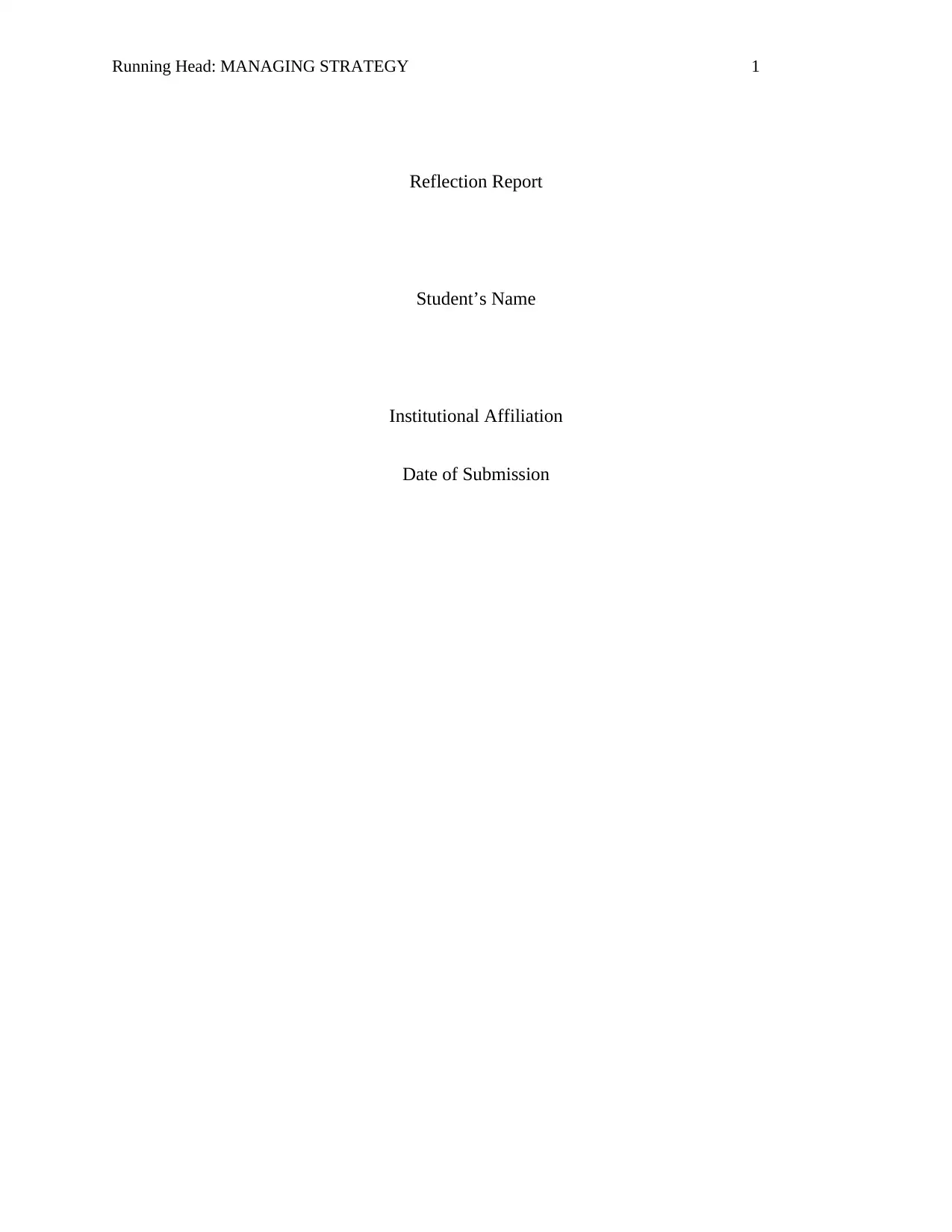
Running Head: MANAGING STRATEGY 1
Reflection Report
Student’s Name
Institutional Affiliation
Date of Submission
Reflection Report
Student’s Name
Institutional Affiliation
Date of Submission
Secure Best Marks with AI Grader
Need help grading? Try our AI Grader for instant feedback on your assignments.
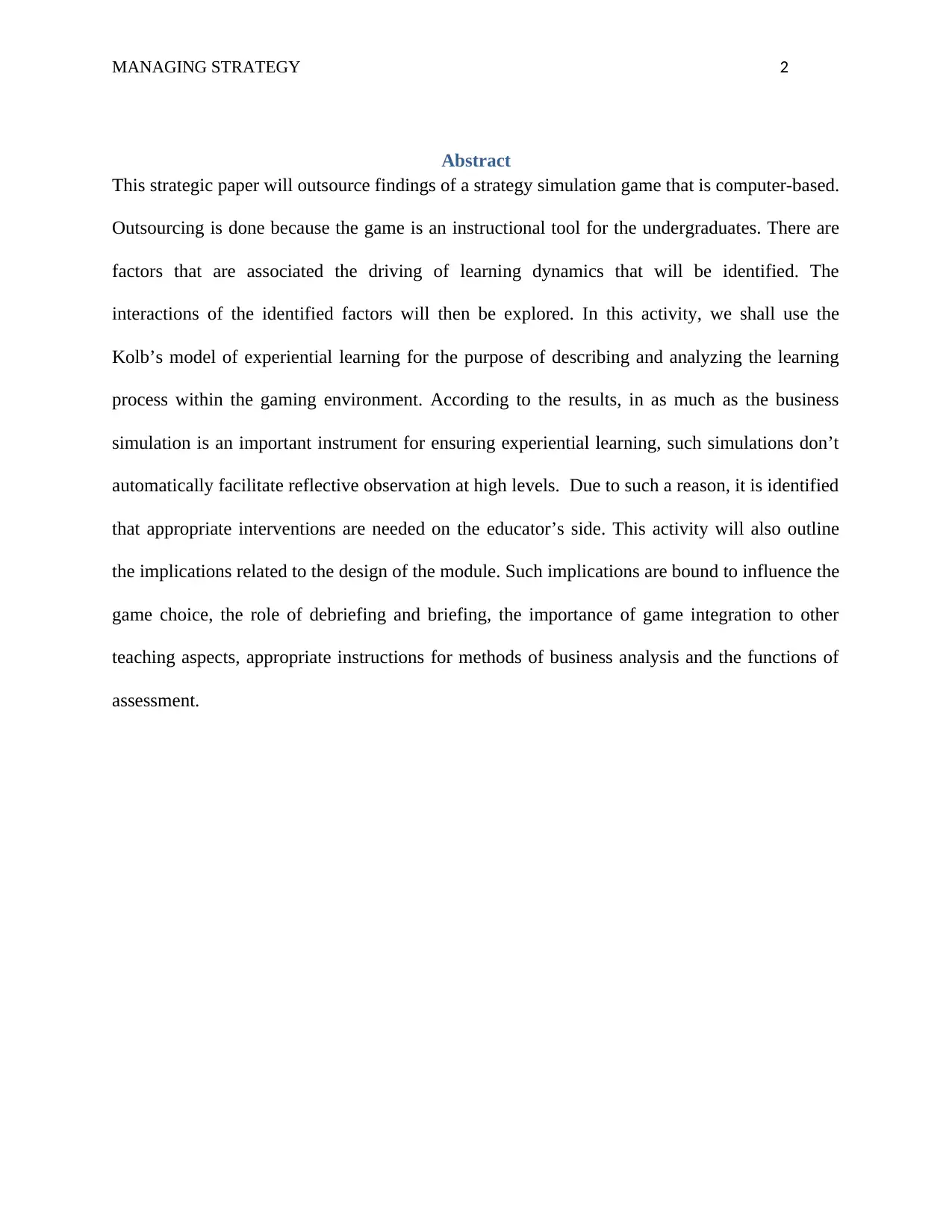
MANAGING STRATEGY 2
Abstract
This strategic paper will outsource findings of a strategy simulation game that is computer-based.
Outsourcing is done because the game is an instructional tool for the undergraduates. There are
factors that are associated the driving of learning dynamics that will be identified. The
interactions of the identified factors will then be explored. In this activity, we shall use the
Kolb’s model of experiential learning for the purpose of describing and analyzing the learning
process within the gaming environment. According to the results, in as much as the business
simulation is an important instrument for ensuring experiential learning, such simulations don’t
automatically facilitate reflective observation at high levels. Due to such a reason, it is identified
that appropriate interventions are needed on the educator’s side. This activity will also outline
the implications related to the design of the module. Such implications are bound to influence the
game choice, the role of debriefing and briefing, the importance of game integration to other
teaching aspects, appropriate instructions for methods of business analysis and the functions of
assessment.
Abstract
This strategic paper will outsource findings of a strategy simulation game that is computer-based.
Outsourcing is done because the game is an instructional tool for the undergraduates. There are
factors that are associated the driving of learning dynamics that will be identified. The
interactions of the identified factors will then be explored. In this activity, we shall use the
Kolb’s model of experiential learning for the purpose of describing and analyzing the learning
process within the gaming environment. According to the results, in as much as the business
simulation is an important instrument for ensuring experiential learning, such simulations don’t
automatically facilitate reflective observation at high levels. Due to such a reason, it is identified
that appropriate interventions are needed on the educator’s side. This activity will also outline
the implications related to the design of the module. Such implications are bound to influence the
game choice, the role of debriefing and briefing, the importance of game integration to other
teaching aspects, appropriate instructions for methods of business analysis and the functions of
assessment.
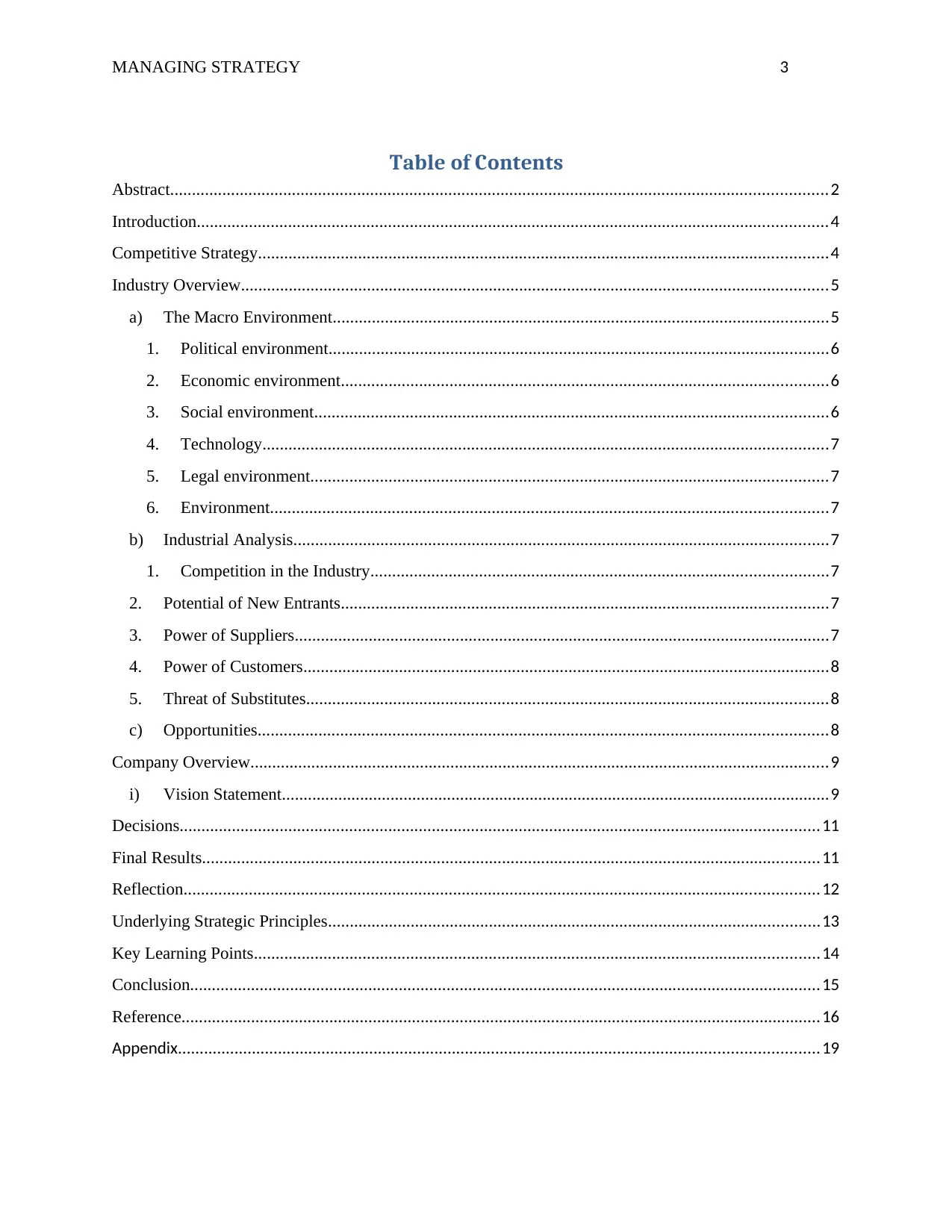
MANAGING STRATEGY 3
Table of Contents
Abstract.......................................................................................................................................................2
Introduction.................................................................................................................................................4
Competitive Strategy...................................................................................................................................4
Industry Overview.......................................................................................................................................5
a) The Macro Environment..................................................................................................................5
1. Political environment...................................................................................................................6
2. Economic environment................................................................................................................6
3. Social environment......................................................................................................................6
4. Technology..................................................................................................................................7
5. Legal environment.......................................................................................................................7
6. Environment................................................................................................................................7
b) Industrial Analysis...........................................................................................................................7
1. Competition in the Industry.........................................................................................................7
2. Potential of New Entrants................................................................................................................7
3. Power of Suppliers...........................................................................................................................7
4. Power of Customers.........................................................................................................................8
5. Threat of Substitutes........................................................................................................................8
c) Opportunities...................................................................................................................................8
Company Overview.....................................................................................................................................9
i) Vision Statement..............................................................................................................................9
Decisions...................................................................................................................................................11
Final Results..............................................................................................................................................11
Reflection..................................................................................................................................................12
Underlying Strategic Principles.................................................................................................................13
Key Learning Points..................................................................................................................................14
Conclusion.................................................................................................................................................15
Reference...................................................................................................................................................16
Appendix...................................................................................................................................................19
Table of Contents
Abstract.......................................................................................................................................................2
Introduction.................................................................................................................................................4
Competitive Strategy...................................................................................................................................4
Industry Overview.......................................................................................................................................5
a) The Macro Environment..................................................................................................................5
1. Political environment...................................................................................................................6
2. Economic environment................................................................................................................6
3. Social environment......................................................................................................................6
4. Technology..................................................................................................................................7
5. Legal environment.......................................................................................................................7
6. Environment................................................................................................................................7
b) Industrial Analysis...........................................................................................................................7
1. Competition in the Industry.........................................................................................................7
2. Potential of New Entrants................................................................................................................7
3. Power of Suppliers...........................................................................................................................7
4. Power of Customers.........................................................................................................................8
5. Threat of Substitutes........................................................................................................................8
c) Opportunities...................................................................................................................................8
Company Overview.....................................................................................................................................9
i) Vision Statement..............................................................................................................................9
Decisions...................................................................................................................................................11
Final Results..............................................................................................................................................11
Reflection..................................................................................................................................................12
Underlying Strategic Principles.................................................................................................................13
Key Learning Points..................................................................................................................................14
Conclusion.................................................................................................................................................15
Reference...................................................................................................................................................16
Appendix...................................................................................................................................................19

MANAGING STRATEGY 4
Secure Best Marks with AI Grader
Need help grading? Try our AI Grader for instant feedback on your assignments.
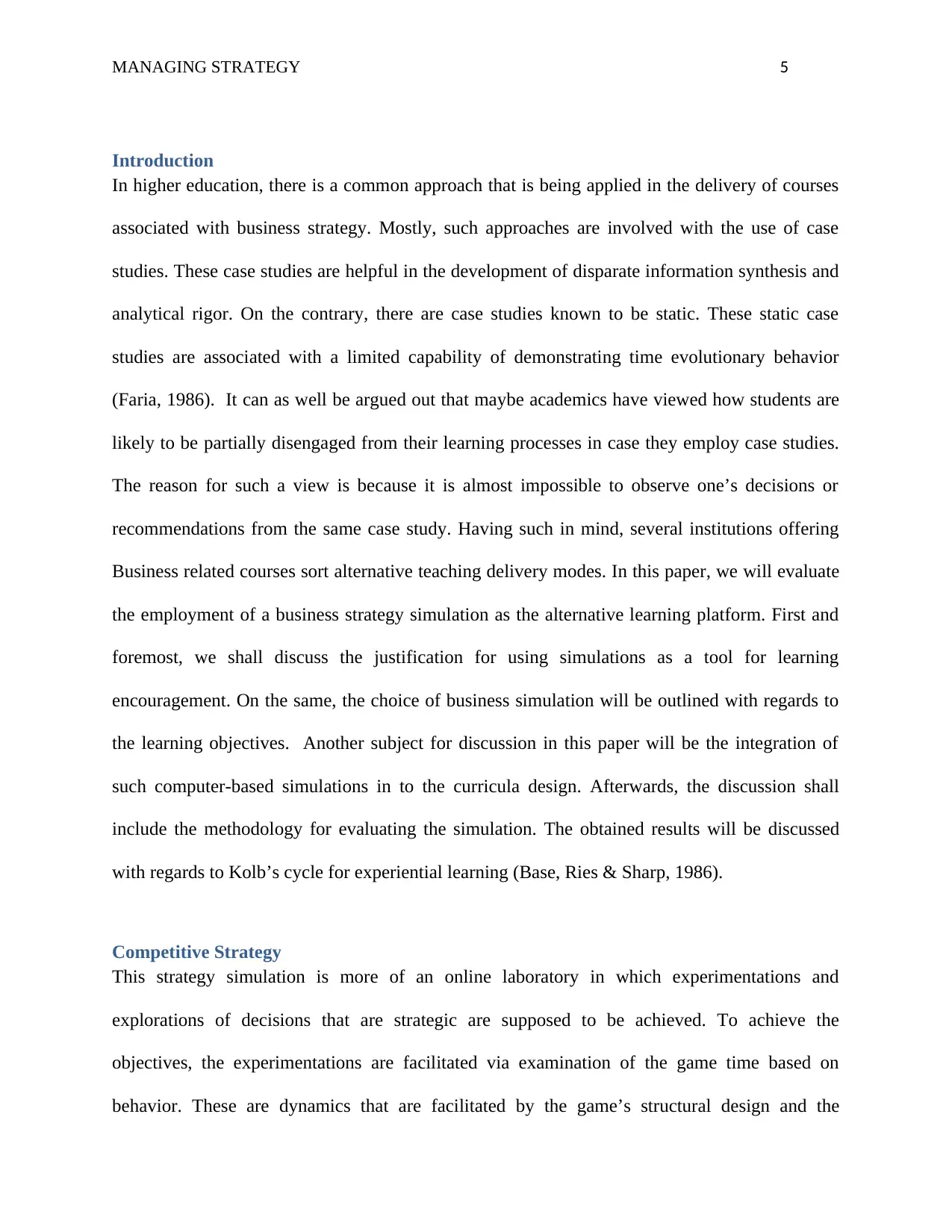
MANAGING STRATEGY 5
Introduction
In higher education, there is a common approach that is being applied in the delivery of courses
associated with business strategy. Mostly, such approaches are involved with the use of case
studies. These case studies are helpful in the development of disparate information synthesis and
analytical rigor. On the contrary, there are case studies known to be static. These static case
studies are associated with a limited capability of demonstrating time evolutionary behavior
(Faria, 1986). It can as well be argued out that maybe academics have viewed how students are
likely to be partially disengaged from their learning processes in case they employ case studies.
The reason for such a view is because it is almost impossible to observe one’s decisions or
recommendations from the same case study. Having such in mind, several institutions offering
Business related courses sort alternative teaching delivery modes. In this paper, we will evaluate
the employment of a business strategy simulation as the alternative learning platform. First and
foremost, we shall discuss the justification for using simulations as a tool for learning
encouragement. On the same, the choice of business simulation will be outlined with regards to
the learning objectives. Another subject for discussion in this paper will be the integration of
such computer-based simulations in to the curricula design. Afterwards, the discussion shall
include the methodology for evaluating the simulation. The obtained results will be discussed
with regards to Kolb’s cycle for experiential learning (Base, Ries & Sharp, 1986).
Competitive Strategy
This strategy simulation is more of an online laboratory in which experimentations and
explorations of decisions that are strategic are supposed to be achieved. To achieve the
objectives, the experimentations are facilitated via examination of the game time based on
behavior. These are dynamics that are facilitated by the game’s structural design and the
Introduction
In higher education, there is a common approach that is being applied in the delivery of courses
associated with business strategy. Mostly, such approaches are involved with the use of case
studies. These case studies are helpful in the development of disparate information synthesis and
analytical rigor. On the contrary, there are case studies known to be static. These static case
studies are associated with a limited capability of demonstrating time evolutionary behavior
(Faria, 1986). It can as well be argued out that maybe academics have viewed how students are
likely to be partially disengaged from their learning processes in case they employ case studies.
The reason for such a view is because it is almost impossible to observe one’s decisions or
recommendations from the same case study. Having such in mind, several institutions offering
Business related courses sort alternative teaching delivery modes. In this paper, we will evaluate
the employment of a business strategy simulation as the alternative learning platform. First and
foremost, we shall discuss the justification for using simulations as a tool for learning
encouragement. On the same, the choice of business simulation will be outlined with regards to
the learning objectives. Another subject for discussion in this paper will be the integration of
such computer-based simulations in to the curricula design. Afterwards, the discussion shall
include the methodology for evaluating the simulation. The obtained results will be discussed
with regards to Kolb’s cycle for experiential learning (Base, Ries & Sharp, 1986).
Competitive Strategy
This strategy simulation is more of an online laboratory in which experimentations and
explorations of decisions that are strategic are supposed to be achieved. To achieve the
objectives, the experimentations are facilitated via examination of the game time based on
behavior. These are dynamics that are facilitated by the game’s structural design and the
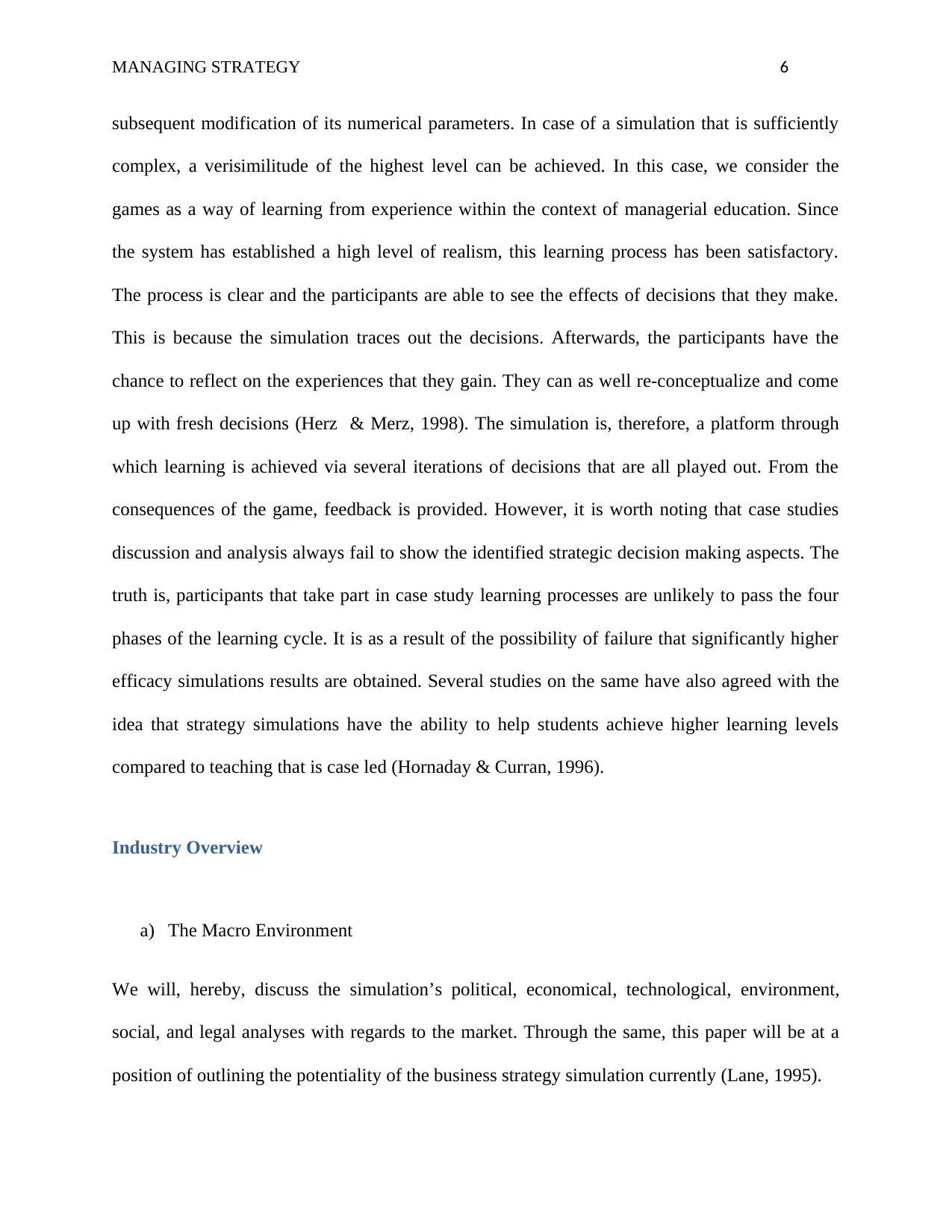
MANAGING STRATEGY 6
subsequent modification of its numerical parameters. In case of a simulation that is sufficiently
complex, a verisimilitude of the highest level can be achieved. In this case, we consider the
games as a way of learning from experience within the context of managerial education. Since
the system has established a high level of realism, this learning process has been satisfactory.
The process is clear and the participants are able to see the effects of decisions that they make.
This is because the simulation traces out the decisions. Afterwards, the participants have the
chance to reflect on the experiences that they gain. They can as well re-conceptualize and come
up with fresh decisions (Herz & Merz, 1998). The simulation is, therefore, a platform through
which learning is achieved via several iterations of decisions that are all played out. From the
consequences of the game, feedback is provided. However, it is worth noting that case studies
discussion and analysis always fail to show the identified strategic decision making aspects. The
truth is, participants that take part in case study learning processes are unlikely to pass the four
phases of the learning cycle. It is as a result of the possibility of failure that significantly higher
efficacy simulations results are obtained. Several studies on the same have also agreed with the
idea that strategy simulations have the ability to help students achieve higher learning levels
compared to teaching that is case led (Hornaday & Curran, 1996).
Industry Overview
a) The Macro Environment
We will, hereby, discuss the simulation’s political, economical, technological, environment,
social, and legal analyses with regards to the market. Through the same, this paper will be at a
position of outlining the potentiality of the business strategy simulation currently (Lane, 1995).
subsequent modification of its numerical parameters. In case of a simulation that is sufficiently
complex, a verisimilitude of the highest level can be achieved. In this case, we consider the
games as a way of learning from experience within the context of managerial education. Since
the system has established a high level of realism, this learning process has been satisfactory.
The process is clear and the participants are able to see the effects of decisions that they make.
This is because the simulation traces out the decisions. Afterwards, the participants have the
chance to reflect on the experiences that they gain. They can as well re-conceptualize and come
up with fresh decisions (Herz & Merz, 1998). The simulation is, therefore, a platform through
which learning is achieved via several iterations of decisions that are all played out. From the
consequences of the game, feedback is provided. However, it is worth noting that case studies
discussion and analysis always fail to show the identified strategic decision making aspects. The
truth is, participants that take part in case study learning processes are unlikely to pass the four
phases of the learning cycle. It is as a result of the possibility of failure that significantly higher
efficacy simulations results are obtained. Several studies on the same have also agreed with the
idea that strategy simulations have the ability to help students achieve higher learning levels
compared to teaching that is case led (Hornaday & Curran, 1996).
Industry Overview
a) The Macro Environment
We will, hereby, discuss the simulation’s political, economical, technological, environment,
social, and legal analyses with regards to the market. Through the same, this paper will be at a
position of outlining the potentiality of the business strategy simulation currently (Lane, 1995).
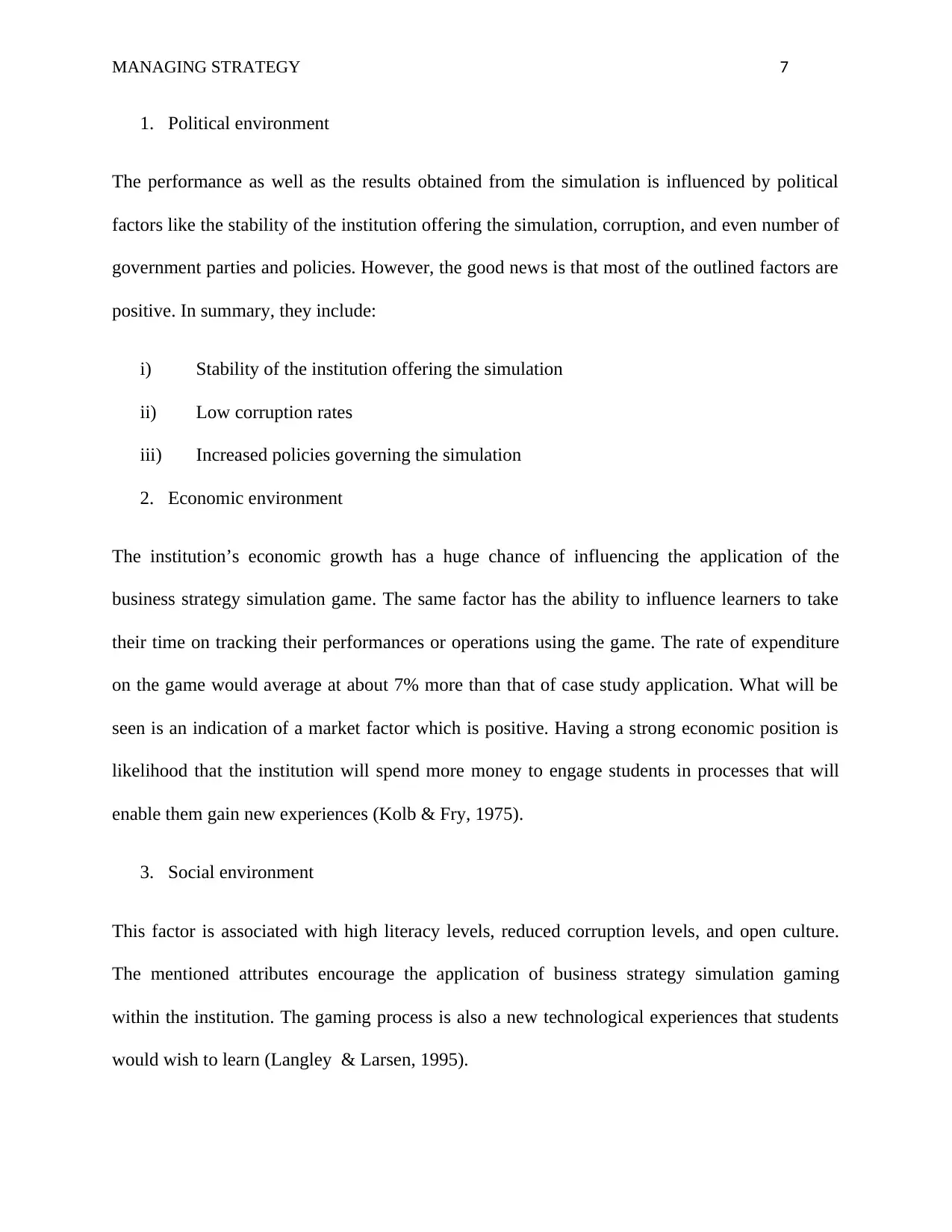
MANAGING STRATEGY 7
1. Political environment
The performance as well as the results obtained from the simulation is influenced by political
factors like the stability of the institution offering the simulation, corruption, and even number of
government parties and policies. However, the good news is that most of the outlined factors are
positive. In summary, they include:
i) Stability of the institution offering the simulation
ii) Low corruption rates
iii) Increased policies governing the simulation
2. Economic environment
The institution’s economic growth has a huge chance of influencing the application of the
business strategy simulation game. The same factor has the ability to influence learners to take
their time on tracking their performances or operations using the game. The rate of expenditure
on the game would average at about 7% more than that of case study application. What will be
seen is an indication of a market factor which is positive. Having a strong economic position is
likelihood that the institution will spend more money to engage students in processes that will
enable them gain new experiences (Kolb & Fry, 1975).
3. Social environment
This factor is associated with high literacy levels, reduced corruption levels, and open culture.
The mentioned attributes encourage the application of business strategy simulation gaming
within the institution. The gaming process is also a new technological experiences that students
would wish to learn (Langley & Larsen, 1995).
1. Political environment
The performance as well as the results obtained from the simulation is influenced by political
factors like the stability of the institution offering the simulation, corruption, and even number of
government parties and policies. However, the good news is that most of the outlined factors are
positive. In summary, they include:
i) Stability of the institution offering the simulation
ii) Low corruption rates
iii) Increased policies governing the simulation
2. Economic environment
The institution’s economic growth has a huge chance of influencing the application of the
business strategy simulation game. The same factor has the ability to influence learners to take
their time on tracking their performances or operations using the game. The rate of expenditure
on the game would average at about 7% more than that of case study application. What will be
seen is an indication of a market factor which is positive. Having a strong economic position is
likelihood that the institution will spend more money to engage students in processes that will
enable them gain new experiences (Kolb & Fry, 1975).
3. Social environment
This factor is associated with high literacy levels, reduced corruption levels, and open culture.
The mentioned attributes encourage the application of business strategy simulation gaming
within the institution. The gaming process is also a new technological experiences that students
would wish to learn (Langley & Larsen, 1995).
Paraphrase This Document
Need a fresh take? Get an instant paraphrase of this document with our AI Paraphraser
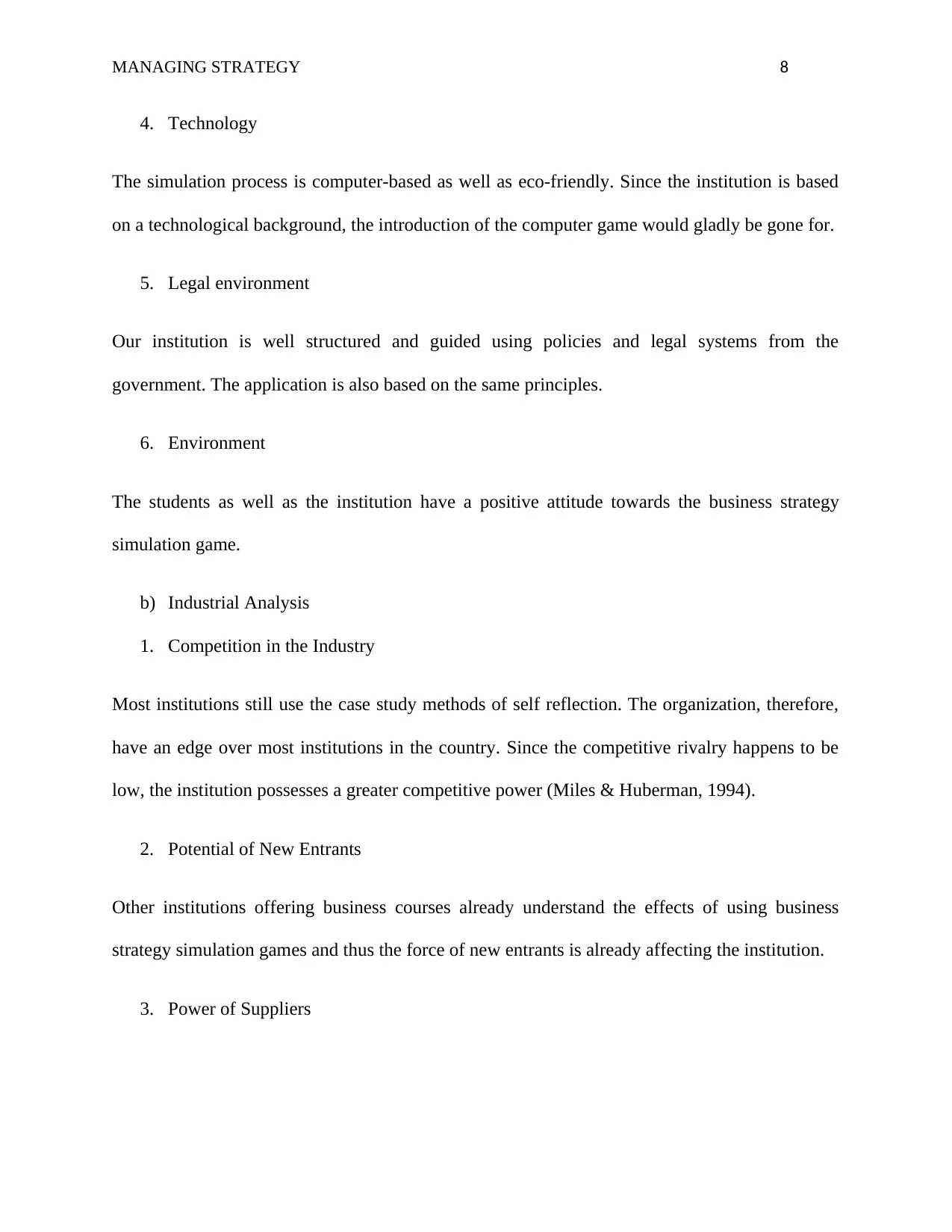
MANAGING STRATEGY 8
4. Technology
The simulation process is computer-based as well as eco-friendly. Since the institution is based
on a technological background, the introduction of the computer game would gladly be gone for.
5. Legal environment
Our institution is well structured and guided using policies and legal systems from the
government. The application is also based on the same principles.
6. Environment
The students as well as the institution have a positive attitude towards the business strategy
simulation game.
b) Industrial Analysis
1. Competition in the Industry
Most institutions still use the case study methods of self reflection. The organization, therefore,
have an edge over most institutions in the country. Since the competitive rivalry happens to be
low, the institution possesses a greater competitive power (Miles & Huberman, 1994).
2. Potential of New Entrants
Other institutions offering business courses already understand the effects of using business
strategy simulation games and thus the force of new entrants is already affecting the institution.
3. Power of Suppliers
4. Technology
The simulation process is computer-based as well as eco-friendly. Since the institution is based
on a technological background, the introduction of the computer game would gladly be gone for.
5. Legal environment
Our institution is well structured and guided using policies and legal systems from the
government. The application is also based on the same principles.
6. Environment
The students as well as the institution have a positive attitude towards the business strategy
simulation game.
b) Industrial Analysis
1. Competition in the Industry
Most institutions still use the case study methods of self reflection. The organization, therefore,
have an edge over most institutions in the country. Since the competitive rivalry happens to be
low, the institution possesses a greater competitive power (Miles & Huberman, 1994).
2. Potential of New Entrants
Other institutions offering business courses already understand the effects of using business
strategy simulation games and thus the force of new entrants is already affecting the institution.
3. Power of Suppliers
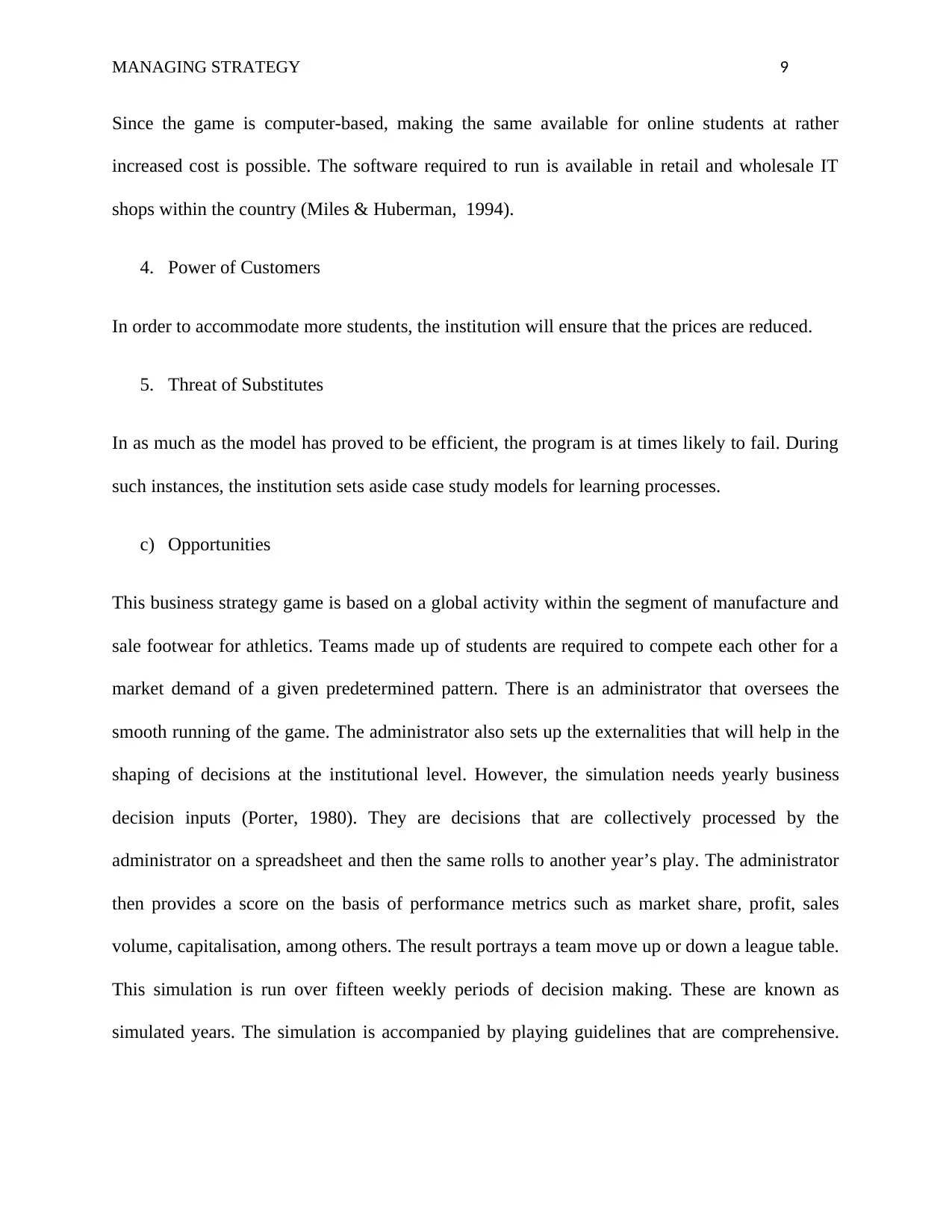
MANAGING STRATEGY 9
Since the game is computer-based, making the same available for online students at rather
increased cost is possible. The software required to run is available in retail and wholesale IT
shops within the country (Miles & Huberman, 1994).
4. Power of Customers
In order to accommodate more students, the institution will ensure that the prices are reduced.
5. Threat of Substitutes
In as much as the model has proved to be efficient, the program is at times likely to fail. During
such instances, the institution sets aside case study models for learning processes.
c) Opportunities
This business strategy game is based on a global activity within the segment of manufacture and
sale footwear for athletics. Teams made up of students are required to compete each other for a
market demand of a given predetermined pattern. There is an administrator that oversees the
smooth running of the game. The administrator also sets up the externalities that will help in the
shaping of decisions at the institutional level. However, the simulation needs yearly business
decision inputs (Porter, 1980). They are decisions that are collectively processed by the
administrator on a spreadsheet and then the same rolls to another year’s play. The administrator
then provides a score on the basis of performance metrics such as market share, profit, sales
volume, capitalisation, among others. The result portrays a team move up or down a league table.
This simulation is run over fifteen weekly periods of decision making. These are known as
simulated years. The simulation is accompanied by playing guidelines that are comprehensive.
Since the game is computer-based, making the same available for online students at rather
increased cost is possible. The software required to run is available in retail and wholesale IT
shops within the country (Miles & Huberman, 1994).
4. Power of Customers
In order to accommodate more students, the institution will ensure that the prices are reduced.
5. Threat of Substitutes
In as much as the model has proved to be efficient, the program is at times likely to fail. During
such instances, the institution sets aside case study models for learning processes.
c) Opportunities
This business strategy game is based on a global activity within the segment of manufacture and
sale footwear for athletics. Teams made up of students are required to compete each other for a
market demand of a given predetermined pattern. There is an administrator that oversees the
smooth running of the game. The administrator also sets up the externalities that will help in the
shaping of decisions at the institutional level. However, the simulation needs yearly business
decision inputs (Porter, 1980). They are decisions that are collectively processed by the
administrator on a spreadsheet and then the same rolls to another year’s play. The administrator
then provides a score on the basis of performance metrics such as market share, profit, sales
volume, capitalisation, among others. The result portrays a team move up or down a league table.
This simulation is run over fifteen weekly periods of decision making. These are known as
simulated years. The simulation is accompanied by playing guidelines that are comprehensive.
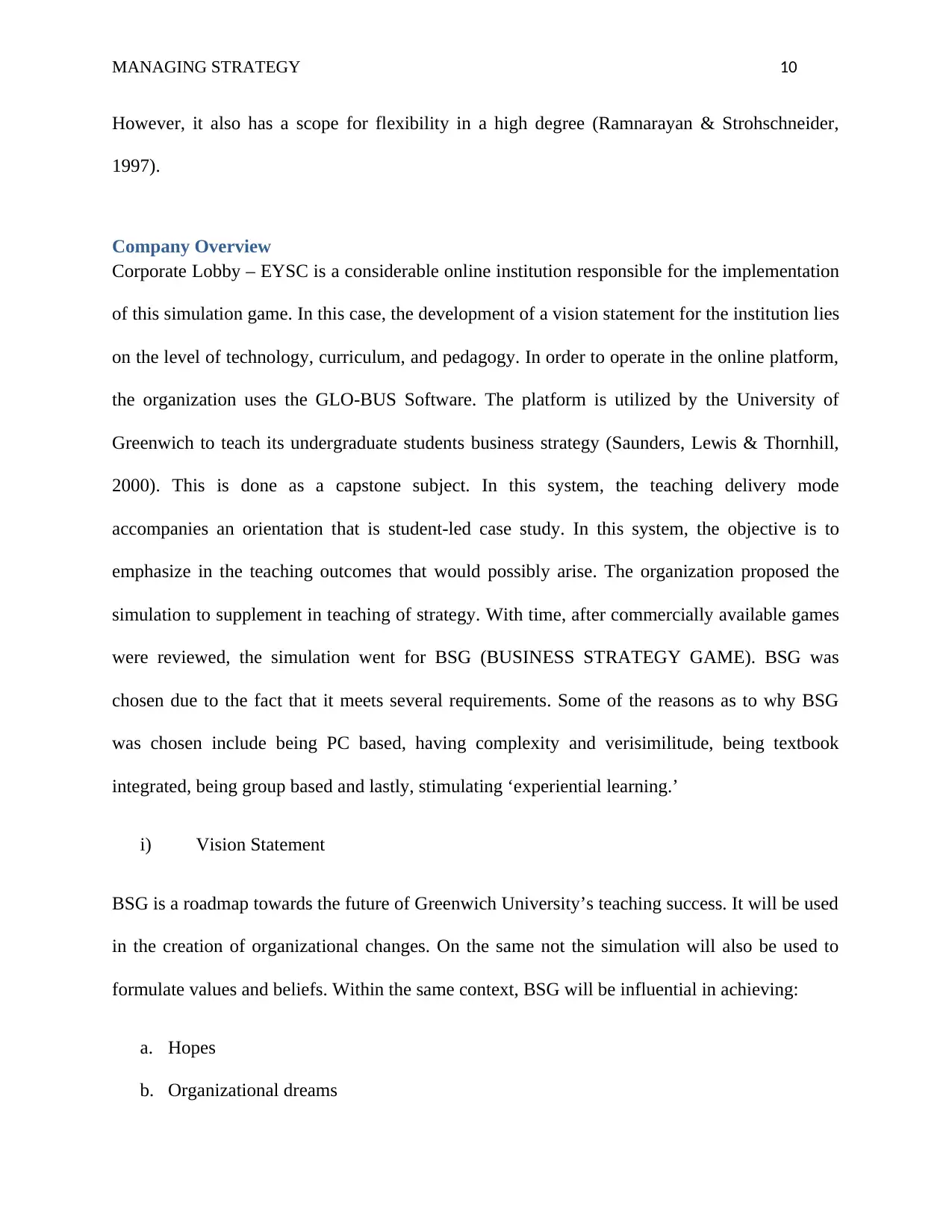
MANAGING STRATEGY 10
However, it also has a scope for flexibility in a high degree (Ramnarayan & Strohschneider,
1997).
Company Overview
Corporate Lobby – EYSC is a considerable online institution responsible for the implementation
of this simulation game. In this case, the development of a vision statement for the institution lies
on the level of technology, curriculum, and pedagogy. In order to operate in the online platform,
the organization uses the GLO-BUS Software. The platform is utilized by the University of
Greenwich to teach its undergraduate students business strategy (Saunders, Lewis & Thornhill,
2000). This is done as a capstone subject. In this system, the teaching delivery mode
accompanies an orientation that is student-led case study. In this system, the objective is to
emphasize in the teaching outcomes that would possibly arise. The organization proposed the
simulation to supplement in teaching of strategy. With time, after commercially available games
were reviewed, the simulation went for BSG (BUSINESS STRATEGY GAME). BSG was
chosen due to the fact that it meets several requirements. Some of the reasons as to why BSG
was chosen include being PC based, having complexity and verisimilitude, being textbook
integrated, being group based and lastly, stimulating ‘experiential learning.’
i) Vision Statement
BSG is a roadmap towards the future of Greenwich University’s teaching success. It will be used
in the creation of organizational changes. On the same not the simulation will also be used to
formulate values and beliefs. Within the same context, BSG will be influential in achieving:
a. Hopes
b. Organizational dreams
However, it also has a scope for flexibility in a high degree (Ramnarayan & Strohschneider,
1997).
Company Overview
Corporate Lobby – EYSC is a considerable online institution responsible for the implementation
of this simulation game. In this case, the development of a vision statement for the institution lies
on the level of technology, curriculum, and pedagogy. In order to operate in the online platform,
the organization uses the GLO-BUS Software. The platform is utilized by the University of
Greenwich to teach its undergraduate students business strategy (Saunders, Lewis & Thornhill,
2000). This is done as a capstone subject. In this system, the teaching delivery mode
accompanies an orientation that is student-led case study. In this system, the objective is to
emphasize in the teaching outcomes that would possibly arise. The organization proposed the
simulation to supplement in teaching of strategy. With time, after commercially available games
were reviewed, the simulation went for BSG (BUSINESS STRATEGY GAME). BSG was
chosen due to the fact that it meets several requirements. Some of the reasons as to why BSG
was chosen include being PC based, having complexity and verisimilitude, being textbook
integrated, being group based and lastly, stimulating ‘experiential learning.’
i) Vision Statement
BSG is a roadmap towards the future of Greenwich University’s teaching success. It will be used
in the creation of organizational changes. On the same not the simulation will also be used to
formulate values and beliefs. Within the same context, BSG will be influential in achieving:
a. Hopes
b. Organizational dreams
Secure Best Marks with AI Grader
Need help grading? Try our AI Grader for instant feedback on your assignments.
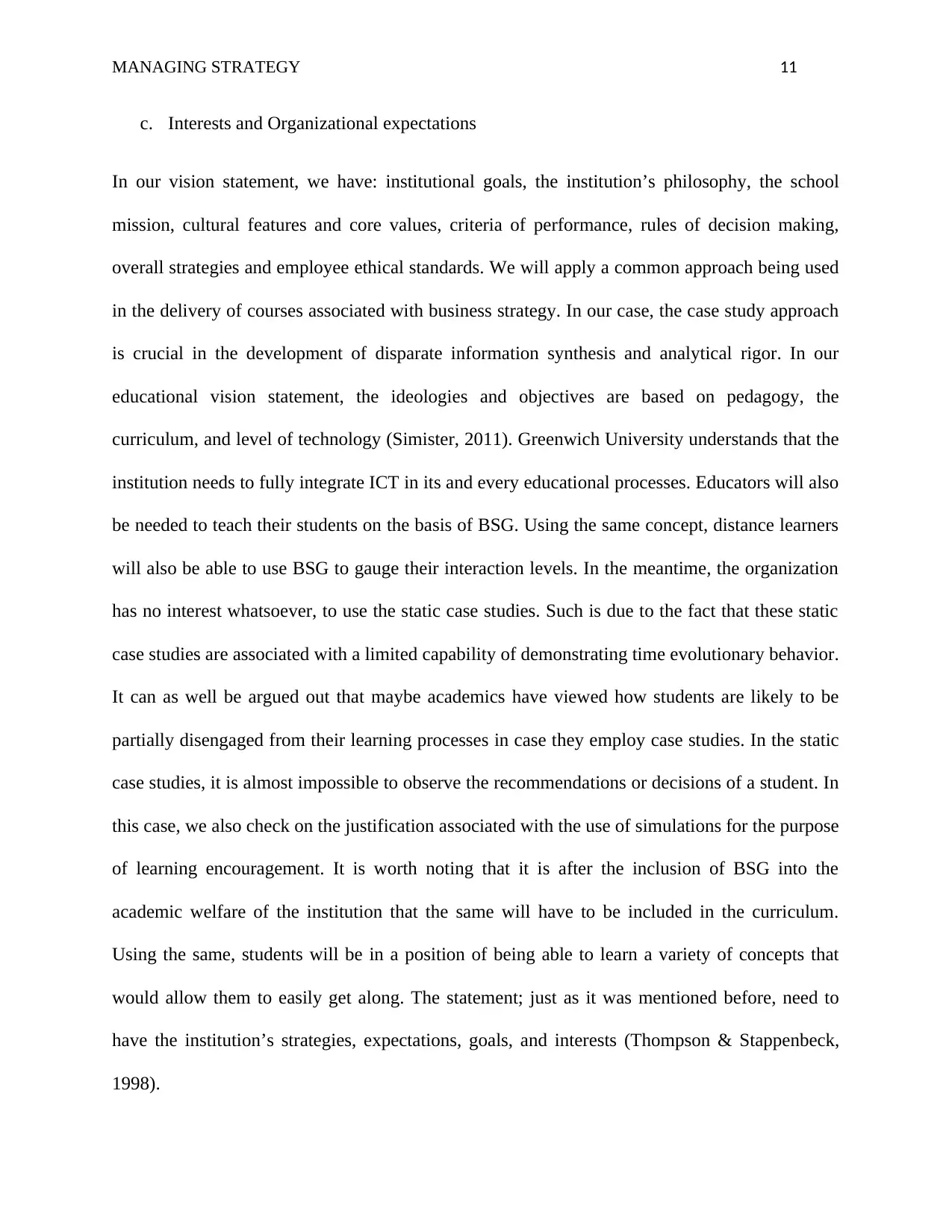
MANAGING STRATEGY 11
c. Interests and Organizational expectations
In our vision statement, we have: institutional goals, the institution’s philosophy, the school
mission, cultural features and core values, criteria of performance, rules of decision making,
overall strategies and employee ethical standards. We will apply a common approach being used
in the delivery of courses associated with business strategy. In our case, the case study approach
is crucial in the development of disparate information synthesis and analytical rigor. In our
educational vision statement, the ideologies and objectives are based on pedagogy, the
curriculum, and level of technology (Simister, 2011). Greenwich University understands that the
institution needs to fully integrate ICT in its and every educational processes. Educators will also
be needed to teach their students on the basis of BSG. Using the same concept, distance learners
will also be able to use BSG to gauge their interaction levels. In the meantime, the organization
has no interest whatsoever, to use the static case studies. Such is due to the fact that these static
case studies are associated with a limited capability of demonstrating time evolutionary behavior.
It can as well be argued out that maybe academics have viewed how students are likely to be
partially disengaged from their learning processes in case they employ case studies. In the static
case studies, it is almost impossible to observe the recommendations or decisions of a student. In
this case, we also check on the justification associated with the use of simulations for the purpose
of learning encouragement. It is worth noting that it is after the inclusion of BSG into the
academic welfare of the institution that the same will have to be included in the curriculum.
Using the same, students will be in a position of being able to learn a variety of concepts that
would allow them to easily get along. The statement; just as it was mentioned before, need to
have the institution’s strategies, expectations, goals, and interests (Thompson & Stappenbeck,
1998).
c. Interests and Organizational expectations
In our vision statement, we have: institutional goals, the institution’s philosophy, the school
mission, cultural features and core values, criteria of performance, rules of decision making,
overall strategies and employee ethical standards. We will apply a common approach being used
in the delivery of courses associated with business strategy. In our case, the case study approach
is crucial in the development of disparate information synthesis and analytical rigor. In our
educational vision statement, the ideologies and objectives are based on pedagogy, the
curriculum, and level of technology (Simister, 2011). Greenwich University understands that the
institution needs to fully integrate ICT in its and every educational processes. Educators will also
be needed to teach their students on the basis of BSG. Using the same concept, distance learners
will also be able to use BSG to gauge their interaction levels. In the meantime, the organization
has no interest whatsoever, to use the static case studies. Such is due to the fact that these static
case studies are associated with a limited capability of demonstrating time evolutionary behavior.
It can as well be argued out that maybe academics have viewed how students are likely to be
partially disengaged from their learning processes in case they employ case studies. In the static
case studies, it is almost impossible to observe the recommendations or decisions of a student. In
this case, we also check on the justification associated with the use of simulations for the purpose
of learning encouragement. It is worth noting that it is after the inclusion of BSG into the
academic welfare of the institution that the same will have to be included in the curriculum.
Using the same, students will be in a position of being able to learn a variety of concepts that
would allow them to easily get along. The statement; just as it was mentioned before, need to
have the institution’s strategies, expectations, goals, and interests (Thompson & Stappenbeck,
1998).
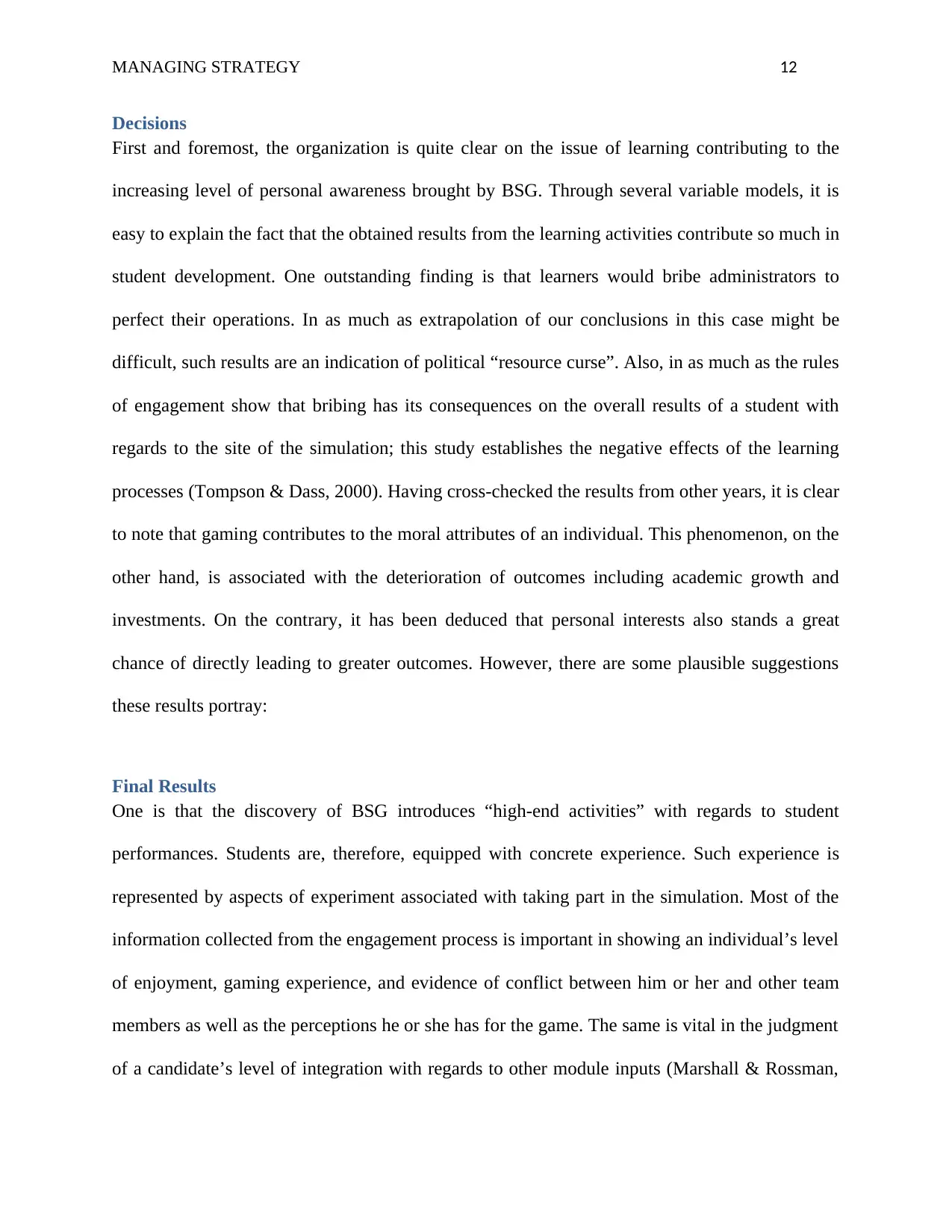
MANAGING STRATEGY 12
Decisions
First and foremost, the organization is quite clear on the issue of learning contributing to the
increasing level of personal awareness brought by BSG. Through several variable models, it is
easy to explain the fact that the obtained results from the learning activities contribute so much in
student development. One outstanding finding is that learners would bribe administrators to
perfect their operations. In as much as extrapolation of our conclusions in this case might be
difficult, such results are an indication of political “resource curse”. Also, in as much as the rules
of engagement show that bribing has its consequences on the overall results of a student with
regards to the site of the simulation; this study establishes the negative effects of the learning
processes (Tompson & Dass, 2000). Having cross-checked the results from other years, it is clear
to note that gaming contributes to the moral attributes of an individual. This phenomenon, on the
other hand, is associated with the deterioration of outcomes including academic growth and
investments. On the contrary, it has been deduced that personal interests also stands a great
chance of directly leading to greater outcomes. However, there are some plausible suggestions
these results portray:
Final Results
One is that the discovery of BSG introduces “high-end activities” with regards to student
performances. Students are, therefore, equipped with concrete experience. Such experience is
represented by aspects of experiment associated with taking part in the simulation. Most of the
information collected from the engagement process is important in showing an individual’s level
of enjoyment, gaming experience, and evidence of conflict between him or her and other team
members as well as the perceptions he or she has for the game. The same is vital in the judgment
of a candidate’s level of integration with regards to other module inputs (Marshall & Rossman,
Decisions
First and foremost, the organization is quite clear on the issue of learning contributing to the
increasing level of personal awareness brought by BSG. Through several variable models, it is
easy to explain the fact that the obtained results from the learning activities contribute so much in
student development. One outstanding finding is that learners would bribe administrators to
perfect their operations. In as much as extrapolation of our conclusions in this case might be
difficult, such results are an indication of political “resource curse”. Also, in as much as the rules
of engagement show that bribing has its consequences on the overall results of a student with
regards to the site of the simulation; this study establishes the negative effects of the learning
processes (Tompson & Dass, 2000). Having cross-checked the results from other years, it is clear
to note that gaming contributes to the moral attributes of an individual. This phenomenon, on the
other hand, is associated with the deterioration of outcomes including academic growth and
investments. On the contrary, it has been deduced that personal interests also stands a great
chance of directly leading to greater outcomes. However, there are some plausible suggestions
these results portray:
Final Results
One is that the discovery of BSG introduces “high-end activities” with regards to student
performances. Students are, therefore, equipped with concrete experience. Such experience is
represented by aspects of experiment associated with taking part in the simulation. Most of the
information collected from the engagement process is important in showing an individual’s level
of enjoyment, gaming experience, and evidence of conflict between him or her and other team
members as well as the perceptions he or she has for the game. The same is vital in the judgment
of a candidate’s level of integration with regards to other module inputs (Marshall & Rossman,
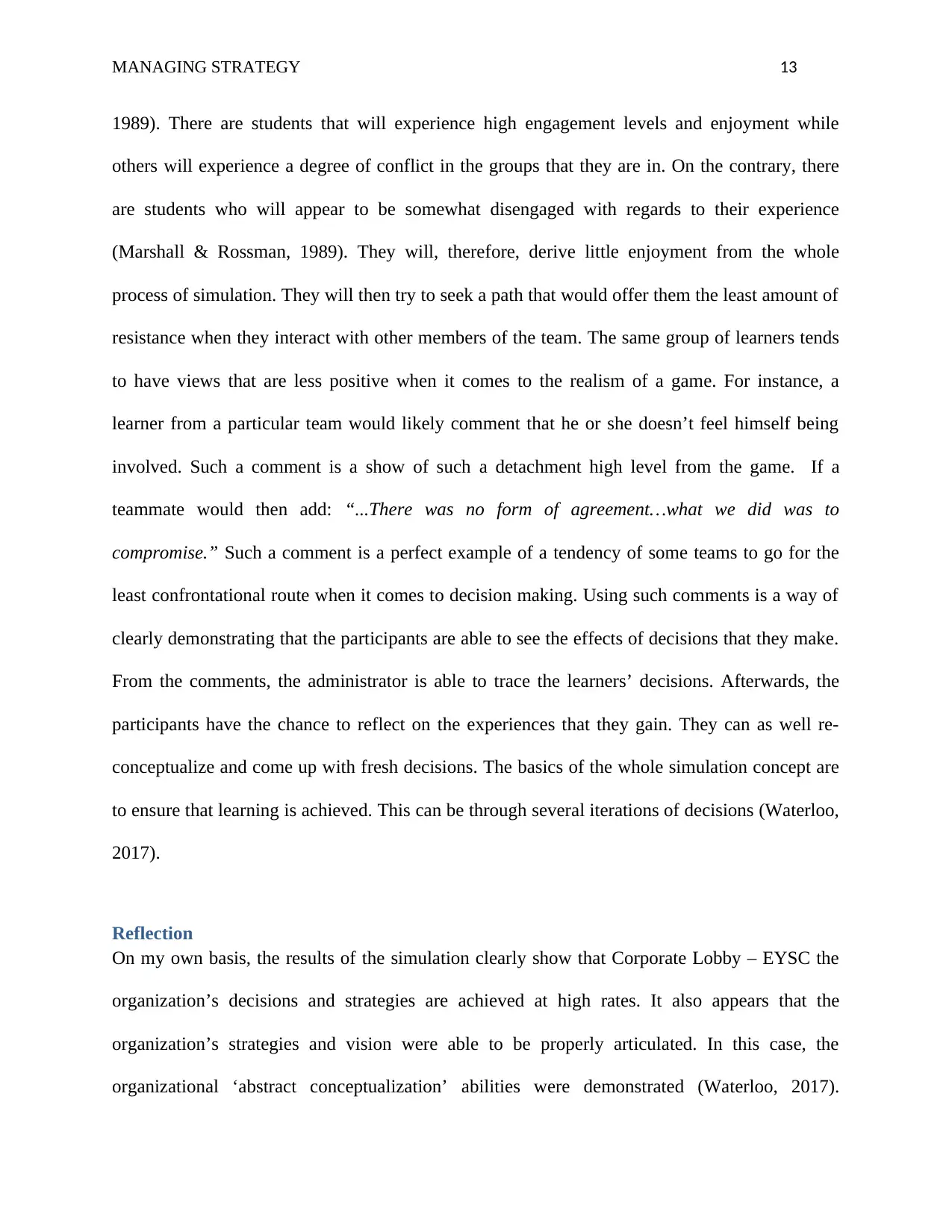
MANAGING STRATEGY 13
1989). There are students that will experience high engagement levels and enjoyment while
others will experience a degree of conflict in the groups that they are in. On the contrary, there
are students who will appear to be somewhat disengaged with regards to their experience
(Marshall & Rossman, 1989). They will, therefore, derive little enjoyment from the whole
process of simulation. They will then try to seek a path that would offer them the least amount of
resistance when they interact with other members of the team. The same group of learners tends
to have views that are less positive when it comes to the realism of a game. For instance, a
learner from a particular team would likely comment that he or she doesn’t feel himself being
involved. Such a comment is a show of such a detachment high level from the game. If a
teammate would then add: “...There was no form of agreement…what we did was to
compromise.” Such a comment is a perfect example of a tendency of some teams to go for the
least confrontational route when it comes to decision making. Using such comments is a way of
clearly demonstrating that the participants are able to see the effects of decisions that they make.
From the comments, the administrator is able to trace the learners’ decisions. Afterwards, the
participants have the chance to reflect on the experiences that they gain. They can as well re-
conceptualize and come up with fresh decisions. The basics of the whole simulation concept are
to ensure that learning is achieved. This can be through several iterations of decisions (Waterloo,
2017).
Reflection
On my own basis, the results of the simulation clearly show that Corporate Lobby – EYSC the
organization’s decisions and strategies are achieved at high rates. It also appears that the
organization’s strategies and vision were able to be properly articulated. In this case, the
organizational ‘abstract conceptualization’ abilities were demonstrated (Waterloo, 2017).
1989). There are students that will experience high engagement levels and enjoyment while
others will experience a degree of conflict in the groups that they are in. On the contrary, there
are students who will appear to be somewhat disengaged with regards to their experience
(Marshall & Rossman, 1989). They will, therefore, derive little enjoyment from the whole
process of simulation. They will then try to seek a path that would offer them the least amount of
resistance when they interact with other members of the team. The same group of learners tends
to have views that are less positive when it comes to the realism of a game. For instance, a
learner from a particular team would likely comment that he or she doesn’t feel himself being
involved. Such a comment is a show of such a detachment high level from the game. If a
teammate would then add: “...There was no form of agreement…what we did was to
compromise.” Such a comment is a perfect example of a tendency of some teams to go for the
least confrontational route when it comes to decision making. Using such comments is a way of
clearly demonstrating that the participants are able to see the effects of decisions that they make.
From the comments, the administrator is able to trace the learners’ decisions. Afterwards, the
participants have the chance to reflect on the experiences that they gain. They can as well re-
conceptualize and come up with fresh decisions. The basics of the whole simulation concept are
to ensure that learning is achieved. This can be through several iterations of decisions (Waterloo,
2017).
Reflection
On my own basis, the results of the simulation clearly show that Corporate Lobby – EYSC the
organization’s decisions and strategies are achieved at high rates. It also appears that the
organization’s strategies and vision were able to be properly articulated. In this case, the
organizational ‘abstract conceptualization’ abilities were demonstrated (Waterloo, 2017).
Paraphrase This Document
Need a fresh take? Get an instant paraphrase of this document with our AI Paraphraser
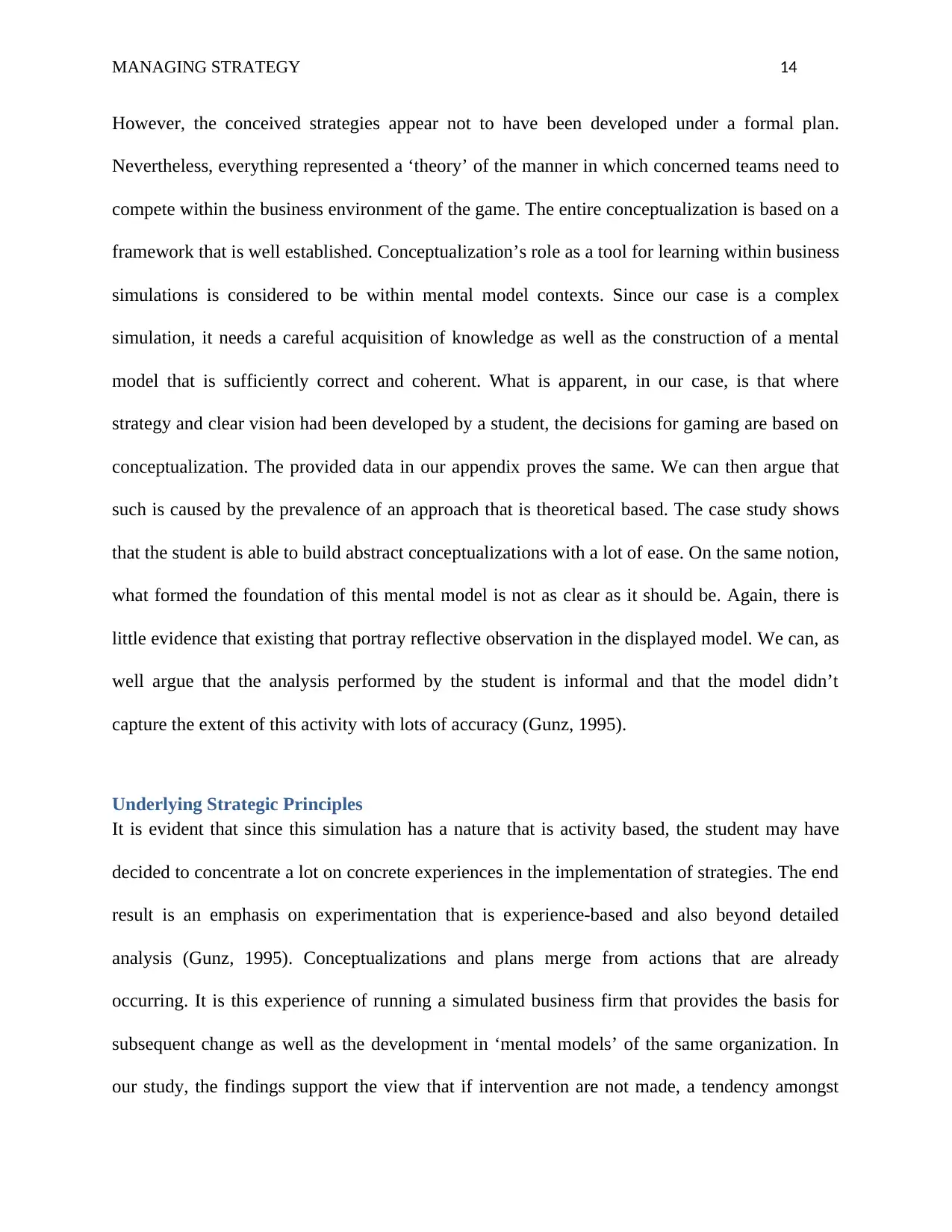
MANAGING STRATEGY 14
However, the conceived strategies appear not to have been developed under a formal plan.
Nevertheless, everything represented a ‘theory’ of the manner in which concerned teams need to
compete within the business environment of the game. The entire conceptualization is based on a
framework that is well established. Conceptualization’s role as a tool for learning within business
simulations is considered to be within mental model contexts. Since our case is a complex
simulation, it needs a careful acquisition of knowledge as well as the construction of a mental
model that is sufficiently correct and coherent. What is apparent, in our case, is that where
strategy and clear vision had been developed by a student, the decisions for gaming are based on
conceptualization. The provided data in our appendix proves the same. We can then argue that
such is caused by the prevalence of an approach that is theoretical based. The case study shows
that the student is able to build abstract conceptualizations with a lot of ease. On the same notion,
what formed the foundation of this mental model is not as clear as it should be. Again, there is
little evidence that existing that portray reflective observation in the displayed model. We can, as
well argue that the analysis performed by the student is informal and that the model didn’t
capture the extent of this activity with lots of accuracy (Gunz, 1995).
Underlying Strategic Principles
It is evident that since this simulation has a nature that is activity based, the student may have
decided to concentrate a lot on concrete experiences in the implementation of strategies. The end
result is an emphasis on experimentation that is experience-based and also beyond detailed
analysis (Gunz, 1995). Conceptualizations and plans merge from actions that are already
occurring. It is this experience of running a simulated business firm that provides the basis for
subsequent change as well as the development in ‘mental models’ of the same organization. In
our study, the findings support the view that if intervention are not made, a tendency amongst
However, the conceived strategies appear not to have been developed under a formal plan.
Nevertheless, everything represented a ‘theory’ of the manner in which concerned teams need to
compete within the business environment of the game. The entire conceptualization is based on a
framework that is well established. Conceptualization’s role as a tool for learning within business
simulations is considered to be within mental model contexts. Since our case is a complex
simulation, it needs a careful acquisition of knowledge as well as the construction of a mental
model that is sufficiently correct and coherent. What is apparent, in our case, is that where
strategy and clear vision had been developed by a student, the decisions for gaming are based on
conceptualization. The provided data in our appendix proves the same. We can then argue that
such is caused by the prevalence of an approach that is theoretical based. The case study shows
that the student is able to build abstract conceptualizations with a lot of ease. On the same notion,
what formed the foundation of this mental model is not as clear as it should be. Again, there is
little evidence that existing that portray reflective observation in the displayed model. We can, as
well argue that the analysis performed by the student is informal and that the model didn’t
capture the extent of this activity with lots of accuracy (Gunz, 1995).
Underlying Strategic Principles
It is evident that since this simulation has a nature that is activity based, the student may have
decided to concentrate a lot on concrete experiences in the implementation of strategies. The end
result is an emphasis on experimentation that is experience-based and also beyond detailed
analysis (Gunz, 1995). Conceptualizations and plans merge from actions that are already
occurring. It is this experience of running a simulated business firm that provides the basis for
subsequent change as well as the development in ‘mental models’ of the same organization. In
our study, the findings support the view that if intervention are not made, a tendency amongst
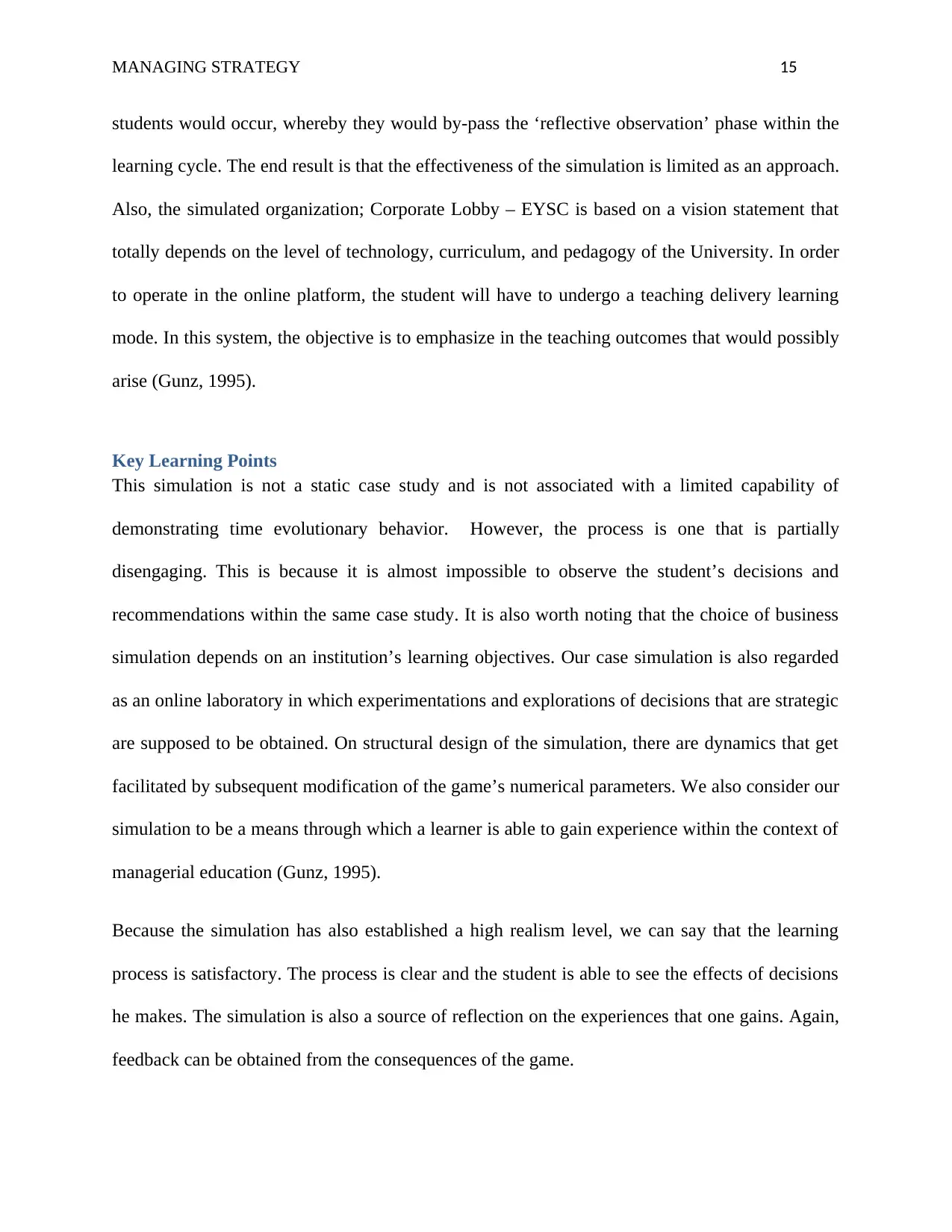
MANAGING STRATEGY 15
students would occur, whereby they would by-pass the ‘reflective observation’ phase within the
learning cycle. The end result is that the effectiveness of the simulation is limited as an approach.
Also, the simulated organization; Corporate Lobby – EYSC is based on a vision statement that
totally depends on the level of technology, curriculum, and pedagogy of the University. In order
to operate in the online platform, the student will have to undergo a teaching delivery learning
mode. In this system, the objective is to emphasize in the teaching outcomes that would possibly
arise (Gunz, 1995).
Key Learning Points
This simulation is not a static case study and is not associated with a limited capability of
demonstrating time evolutionary behavior. However, the process is one that is partially
disengaging. This is because it is almost impossible to observe the student’s decisions and
recommendations within the same case study. It is also worth noting that the choice of business
simulation depends on an institution’s learning objectives. Our case simulation is also regarded
as an online laboratory in which experimentations and explorations of decisions that are strategic
are supposed to be obtained. On structural design of the simulation, there are dynamics that get
facilitated by subsequent modification of the game’s numerical parameters. We also consider our
simulation to be a means through which a learner is able to gain experience within the context of
managerial education (Gunz, 1995).
Because the simulation has also established a high realism level, we can say that the learning
process is satisfactory. The process is clear and the student is able to see the effects of decisions
he makes. The simulation is also a source of reflection on the experiences that one gains. Again,
feedback can be obtained from the consequences of the game.
students would occur, whereby they would by-pass the ‘reflective observation’ phase within the
learning cycle. The end result is that the effectiveness of the simulation is limited as an approach.
Also, the simulated organization; Corporate Lobby – EYSC is based on a vision statement that
totally depends on the level of technology, curriculum, and pedagogy of the University. In order
to operate in the online platform, the student will have to undergo a teaching delivery learning
mode. In this system, the objective is to emphasize in the teaching outcomes that would possibly
arise (Gunz, 1995).
Key Learning Points
This simulation is not a static case study and is not associated with a limited capability of
demonstrating time evolutionary behavior. However, the process is one that is partially
disengaging. This is because it is almost impossible to observe the student’s decisions and
recommendations within the same case study. It is also worth noting that the choice of business
simulation depends on an institution’s learning objectives. Our case simulation is also regarded
as an online laboratory in which experimentations and explorations of decisions that are strategic
are supposed to be obtained. On structural design of the simulation, there are dynamics that get
facilitated by subsequent modification of the game’s numerical parameters. We also consider our
simulation to be a means through which a learner is able to gain experience within the context of
managerial education (Gunz, 1995).
Because the simulation has also established a high realism level, we can say that the learning
process is satisfactory. The process is clear and the student is able to see the effects of decisions
he makes. The simulation is also a source of reflection on the experiences that one gains. Again,
feedback can be obtained from the consequences of the game.
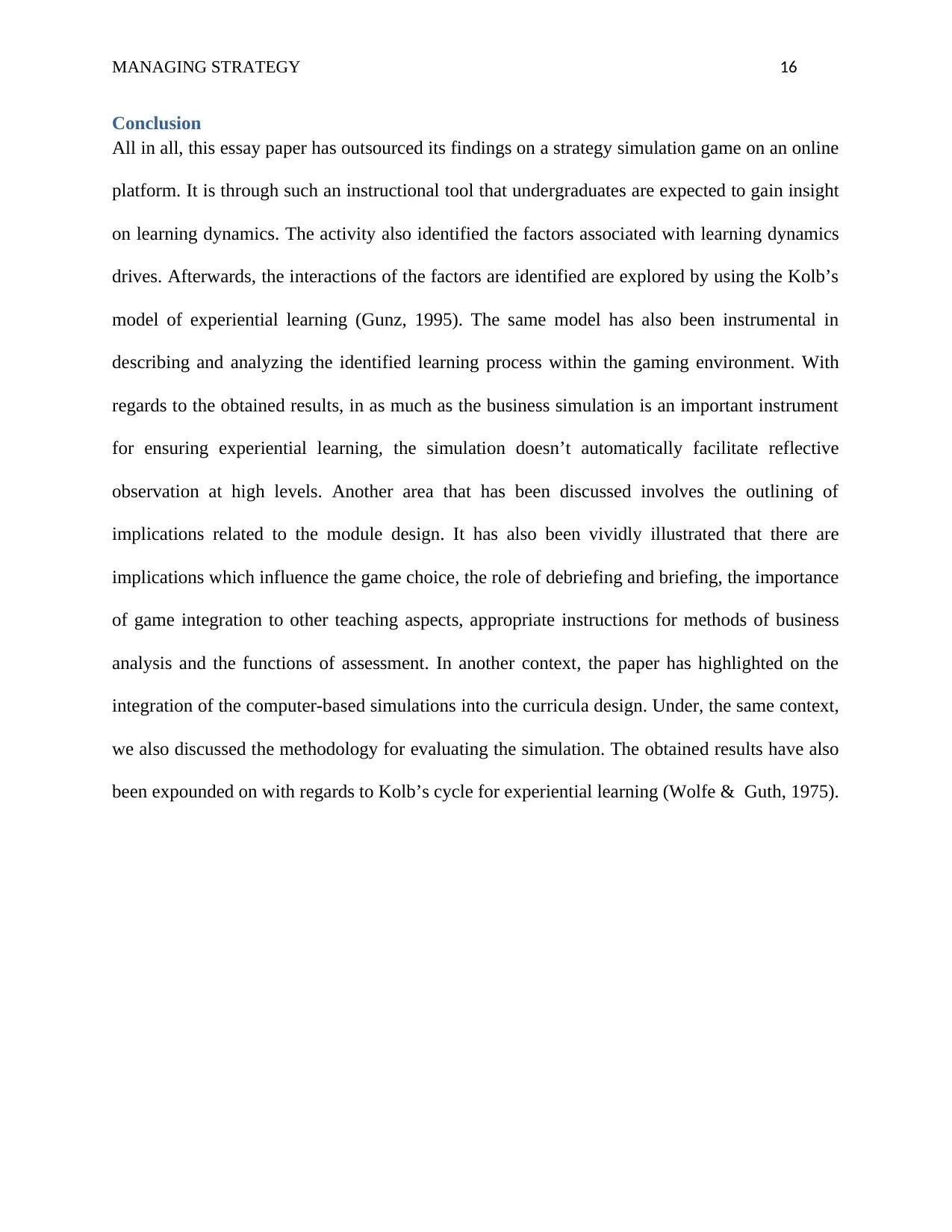
MANAGING STRATEGY 16
Conclusion
All in all, this essay paper has outsourced its findings on a strategy simulation game on an online
platform. It is through such an instructional tool that undergraduates are expected to gain insight
on learning dynamics. The activity also identified the factors associated with learning dynamics
drives. Afterwards, the interactions of the factors are identified are explored by using the Kolb’s
model of experiential learning (Gunz, 1995). The same model has also been instrumental in
describing and analyzing the identified learning process within the gaming environment. With
regards to the obtained results, in as much as the business simulation is an important instrument
for ensuring experiential learning, the simulation doesn’t automatically facilitate reflective
observation at high levels. Another area that has been discussed involves the outlining of
implications related to the module design. It has also been vividly illustrated that there are
implications which influence the game choice, the role of debriefing and briefing, the importance
of game integration to other teaching aspects, appropriate instructions for methods of business
analysis and the functions of assessment. In another context, the paper has highlighted on the
integration of the computer-based simulations into the curricula design. Under, the same context,
we also discussed the methodology for evaluating the simulation. The obtained results have also
been expounded on with regards to Kolb’s cycle for experiential learning (Wolfe & Guth, 1975).
Conclusion
All in all, this essay paper has outsourced its findings on a strategy simulation game on an online
platform. It is through such an instructional tool that undergraduates are expected to gain insight
on learning dynamics. The activity also identified the factors associated with learning dynamics
drives. Afterwards, the interactions of the factors are identified are explored by using the Kolb’s
model of experiential learning (Gunz, 1995). The same model has also been instrumental in
describing and analyzing the identified learning process within the gaming environment. With
regards to the obtained results, in as much as the business simulation is an important instrument
for ensuring experiential learning, the simulation doesn’t automatically facilitate reflective
observation at high levels. Another area that has been discussed involves the outlining of
implications related to the module design. It has also been vividly illustrated that there are
implications which influence the game choice, the role of debriefing and briefing, the importance
of game integration to other teaching aspects, appropriate instructions for methods of business
analysis and the functions of assessment. In another context, the paper has highlighted on the
integration of the computer-based simulations into the curricula design. Under, the same context,
we also discussed the methodology for evaluating the simulation. The obtained results have also
been expounded on with regards to Kolb’s cycle for experiential learning (Wolfe & Guth, 1975).
Secure Best Marks with AI Grader
Need help grading? Try our AI Grader for instant feedback on your assignments.

MANAGING STRATEGY 17
Reference
Reference
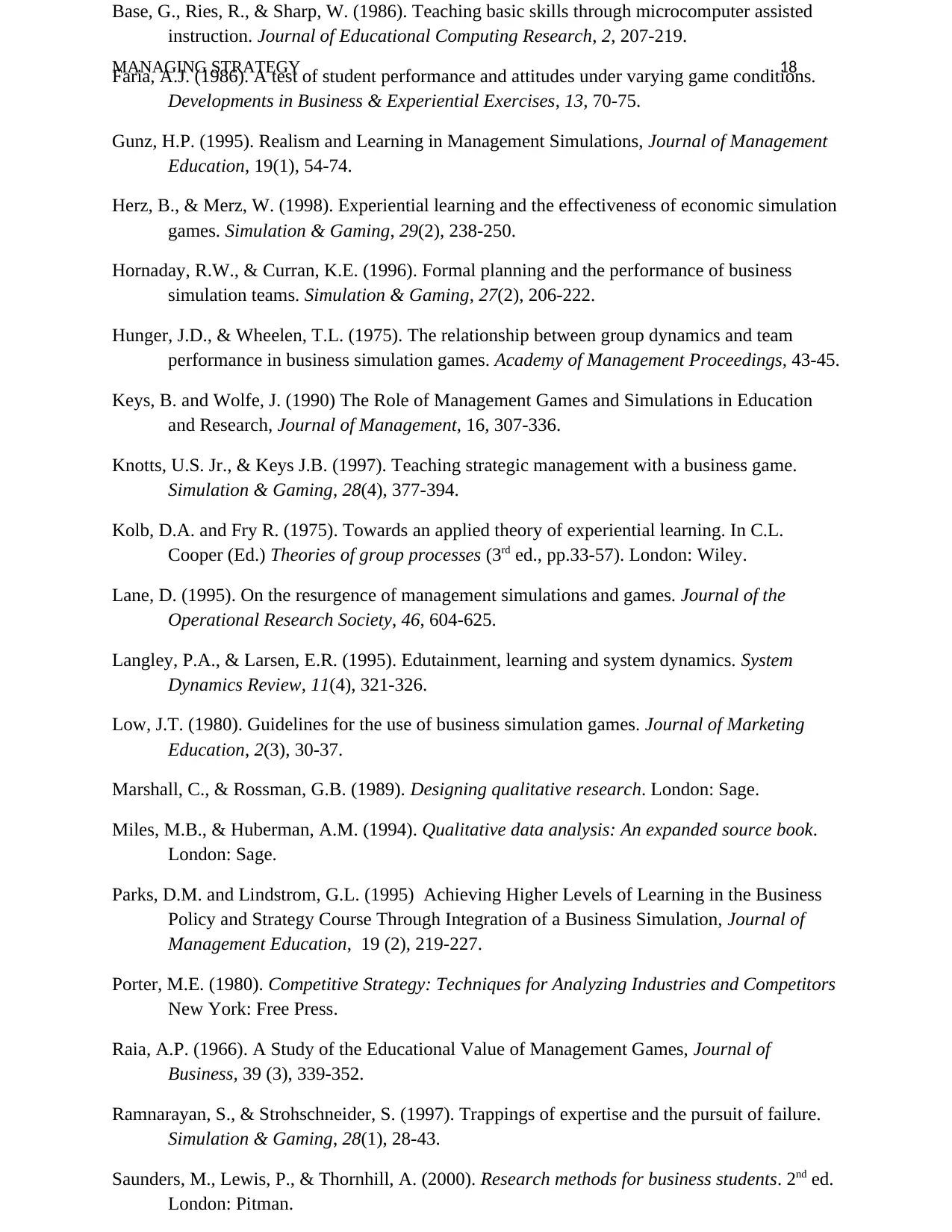
MANAGING STRATEGY 18
Base, G., Ries, R., & Sharp, W. (1986). Teaching basic skills through microcomputer assisted
instruction. Journal of Educational Computing Research, 2, 207-219.
Faria, A.J. (1986). A test of student performance and attitudes under varying game conditions.
Developments in Business & Experiential Exercises, 13, 70-75.
Gunz, H.P. (1995). Realism and Learning in Management Simulations, Journal of Management
Education, 19(1), 54-74.
Herz, B., & Merz, W. (1998). Experiential learning and the effectiveness of economic simulation
games. Simulation & Gaming, 29(2), 238-250.
Hornaday, R.W., & Curran, K.E. (1996). Formal planning and the performance of business
simulation teams. Simulation & Gaming, 27(2), 206-222.
Hunger, J.D., & Wheelen, T.L. (1975). The relationship between group dynamics and team
performance in business simulation games. Academy of Management Proceedings, 43-45.
Keys, B. and Wolfe, J. (1990) The Role of Management Games and Simulations in Education
and Research, Journal of Management, 16, 307-336.
Knotts, U.S. Jr., & Keys J.B. (1997). Teaching strategic management with a business game.
Simulation & Gaming, 28(4), 377-394.
Kolb, D.A. and Fry R. (1975). Towards an applied theory of experiential learning. In C.L.
Cooper (Ed.) Theories of group processes (3rd ed., pp.33-57). London: Wiley.
Lane, D. (1995). On the resurgence of management simulations and games. Journal of the
Operational Research Society, 46, 604-625.
Langley, P.A., & Larsen, E.R. (1995). Edutainment, learning and system dynamics. System
Dynamics Review, 11(4), 321-326.
Low, J.T. (1980). Guidelines for the use of business simulation games. Journal of Marketing
Education, 2(3), 30-37.
Marshall, C., & Rossman, G.B. (1989). Designing qualitative research. London: Sage.
Miles, M.B., & Huberman, A.M. (1994). Qualitative data analysis: An expanded source book.
London: Sage.
Parks, D.M. and Lindstrom, G.L. (1995) Achieving Higher Levels of Learning in the Business
Policy and Strategy Course Through Integration of a Business Simulation, Journal of
Management Education, 19 (2), 219-227.
Porter, M.E. (1980). Competitive Strategy: Techniques for Analyzing Industries and Competitors
New York: Free Press.
Raia, A.P. (1966). A Study of the Educational Value of Management Games, Journal of
Business, 39 (3), 339-352.
Ramnarayan, S., & Strohschneider, S. (1997). Trappings of expertise and the pursuit of failure.
Simulation & Gaming, 28(1), 28-43.
Saunders, M., Lewis, P., & Thornhill, A. (2000). Research methods for business students. 2nd ed.
London: Pitman.
Base, G., Ries, R., & Sharp, W. (1986). Teaching basic skills through microcomputer assisted
instruction. Journal of Educational Computing Research, 2, 207-219.
Faria, A.J. (1986). A test of student performance and attitudes under varying game conditions.
Developments in Business & Experiential Exercises, 13, 70-75.
Gunz, H.P. (1995). Realism and Learning in Management Simulations, Journal of Management
Education, 19(1), 54-74.
Herz, B., & Merz, W. (1998). Experiential learning and the effectiveness of economic simulation
games. Simulation & Gaming, 29(2), 238-250.
Hornaday, R.W., & Curran, K.E. (1996). Formal planning and the performance of business
simulation teams. Simulation & Gaming, 27(2), 206-222.
Hunger, J.D., & Wheelen, T.L. (1975). The relationship between group dynamics and team
performance in business simulation games. Academy of Management Proceedings, 43-45.
Keys, B. and Wolfe, J. (1990) The Role of Management Games and Simulations in Education
and Research, Journal of Management, 16, 307-336.
Knotts, U.S. Jr., & Keys J.B. (1997). Teaching strategic management with a business game.
Simulation & Gaming, 28(4), 377-394.
Kolb, D.A. and Fry R. (1975). Towards an applied theory of experiential learning. In C.L.
Cooper (Ed.) Theories of group processes (3rd ed., pp.33-57). London: Wiley.
Lane, D. (1995). On the resurgence of management simulations and games. Journal of the
Operational Research Society, 46, 604-625.
Langley, P.A., & Larsen, E.R. (1995). Edutainment, learning and system dynamics. System
Dynamics Review, 11(4), 321-326.
Low, J.T. (1980). Guidelines for the use of business simulation games. Journal of Marketing
Education, 2(3), 30-37.
Marshall, C., & Rossman, G.B. (1989). Designing qualitative research. London: Sage.
Miles, M.B., & Huberman, A.M. (1994). Qualitative data analysis: An expanded source book.
London: Sage.
Parks, D.M. and Lindstrom, G.L. (1995) Achieving Higher Levels of Learning in the Business
Policy and Strategy Course Through Integration of a Business Simulation, Journal of
Management Education, 19 (2), 219-227.
Porter, M.E. (1980). Competitive Strategy: Techniques for Analyzing Industries and Competitors
New York: Free Press.
Raia, A.P. (1966). A Study of the Educational Value of Management Games, Journal of
Business, 39 (3), 339-352.
Ramnarayan, S., & Strohschneider, S. (1997). Trappings of expertise and the pursuit of failure.
Simulation & Gaming, 28(1), 28-43.
Saunders, M., Lewis, P., & Thornhill, A. (2000). Research methods for business students. 2nd ed.
London: Pitman.
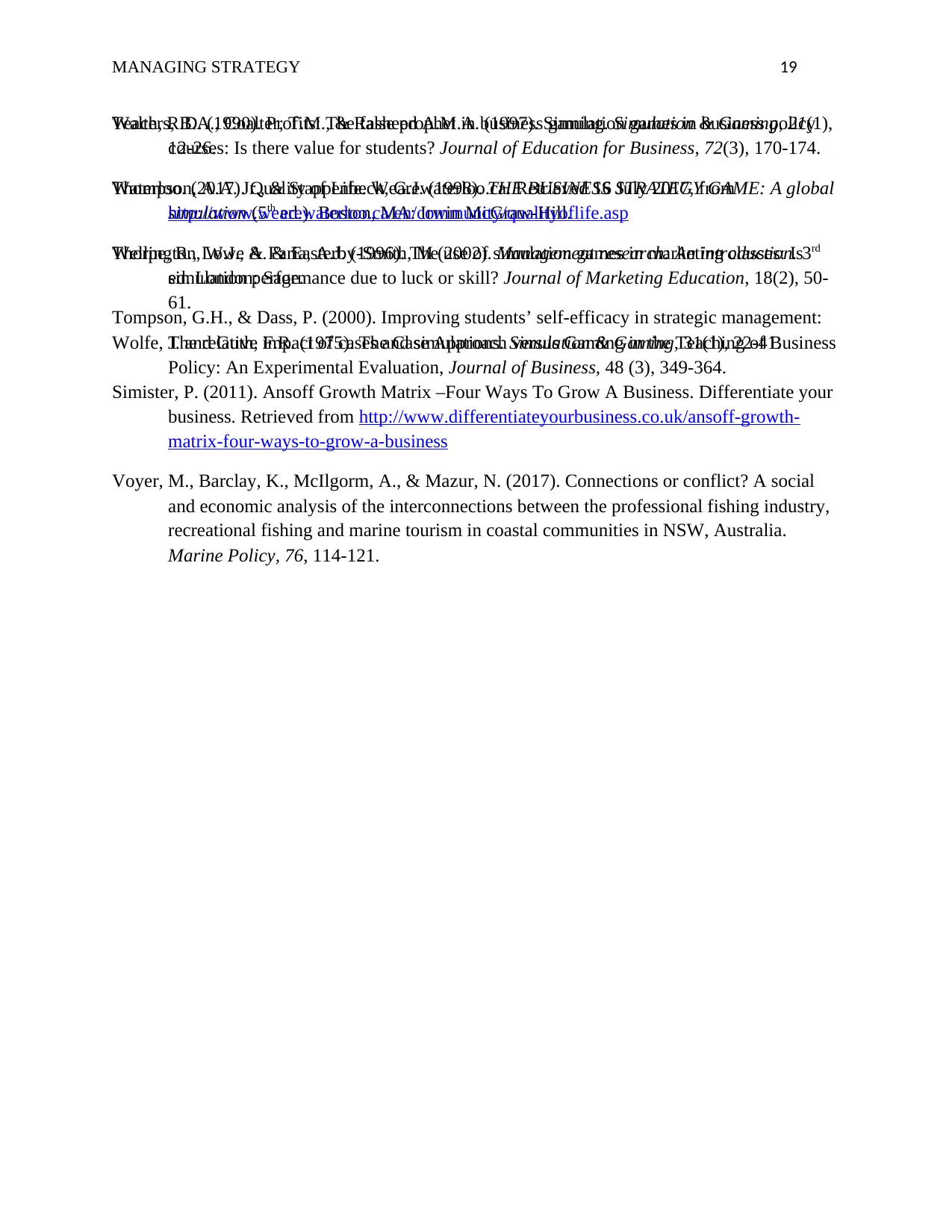
MANAGING STRATEGY 19
Simister, P. (2011). Ansoff Growth Matrix –Four Ways To Grow A Business. Differentiate your
business. Retrieved from http://www.differentiateyourbusiness.co.uk/ansoff-growth-
matrix-four-ways-to-grow-a-business
Voyer, M., Barclay, K., McIlgorm, A., & Mazur, N. (2017). Connections or conflict? A social
and economic analysis of the interconnections between the professional fishing industry,
recreational fishing and marine tourism in coastal communities in NSW, Australia.
Marine Policy, 76, 114-121.
Teach, R.D. (1990). Profits: The false prophet in business gaming. Simulation & Gaming, 21(1),
12-26.
Thompson, A.A. Jr., & Stappenbeck, G.J. (1998). THE BUSINESS STRATEGY GAME: A global
simulation (5th ed.). Boston, MA: Irwin McGraw-Hill.
Thorpe, R., Lowe A. & Easterby-Smith, M (2002). Management research: An introduction. 3rd
ed. London: Sage.
Tompson, G.H., & Dass, P. (2000). Improving students’ self-efficacy in strategic management:
The relative impact of cases and simulations. Simulation & Gaming, 31(1), 22-41.
Walters, B.A., Coalter, T.M., & Rasheed A.M.A. (1997). Simulation games in business policy
courses: Is there value for students? Journal of Education for Business, 72(3), 170-174.
Waterloo. (2017). Quality of Life. Wearewaterloo.ca. Retrieved 16 July 2017, from
http://www.wearewaterloo.ca/en/community/qualityoflife.asp
Wellington, W.J., & Faria, A.J. (1996). The use of simulation games in marketing classes: Is
simulation performance due to luck or skill? Journal of Marketing Education, 18(2), 50-
61.
Wolfe, J. and Guth, F.R. (1975). The Case Approach versus Gaming in the Teaching of Business
Policy: An Experimental Evaluation, Journal of Business, 48 (3), 349-364.
Simister, P. (2011). Ansoff Growth Matrix –Four Ways To Grow A Business. Differentiate your
business. Retrieved from http://www.differentiateyourbusiness.co.uk/ansoff-growth-
matrix-four-ways-to-grow-a-business
Voyer, M., Barclay, K., McIlgorm, A., & Mazur, N. (2017). Connections or conflict? A social
and economic analysis of the interconnections between the professional fishing industry,
recreational fishing and marine tourism in coastal communities in NSW, Australia.
Marine Policy, 76, 114-121.
Teach, R.D. (1990). Profits: The false prophet in business gaming. Simulation & Gaming, 21(1),
12-26.
Thompson, A.A. Jr., & Stappenbeck, G.J. (1998). THE BUSINESS STRATEGY GAME: A global
simulation (5th ed.). Boston, MA: Irwin McGraw-Hill.
Thorpe, R., Lowe A. & Easterby-Smith, M (2002). Management research: An introduction. 3rd
ed. London: Sage.
Tompson, G.H., & Dass, P. (2000). Improving students’ self-efficacy in strategic management:
The relative impact of cases and simulations. Simulation & Gaming, 31(1), 22-41.
Walters, B.A., Coalter, T.M., & Rasheed A.M.A. (1997). Simulation games in business policy
courses: Is there value for students? Journal of Education for Business, 72(3), 170-174.
Waterloo. (2017). Quality of Life. Wearewaterloo.ca. Retrieved 16 July 2017, from
http://www.wearewaterloo.ca/en/community/qualityoflife.asp
Wellington, W.J., & Faria, A.J. (1996). The use of simulation games in marketing classes: Is
simulation performance due to luck or skill? Journal of Marketing Education, 18(2), 50-
61.
Wolfe, J. and Guth, F.R. (1975). The Case Approach versus Gaming in the Teaching of Business
Policy: An Experimental Evaluation, Journal of Business, 48 (3), 349-364.
Paraphrase This Document
Need a fresh take? Get an instant paraphrase of this document with our AI Paraphraser

MANAGING STRATEGY 20
1 out of 20
Your All-in-One AI-Powered Toolkit for Academic Success.
+13062052269
info@desklib.com
Available 24*7 on WhatsApp / Email
![[object Object]](/_next/static/media/star-bottom.7253800d.svg)
Unlock your academic potential
© 2024 | Zucol Services PVT LTD | All rights reserved.


